Kidney mite on currants: control measures
Spring. The currant buds began to swell, and you found that some of them were somehow too swollen ...
Should I worry? Perhaps, but it is fixable.
Next, you will learn what to do if you notice mite buds on the currant, how to get rid of the currant kidney mite, when and how to treat the bushes.
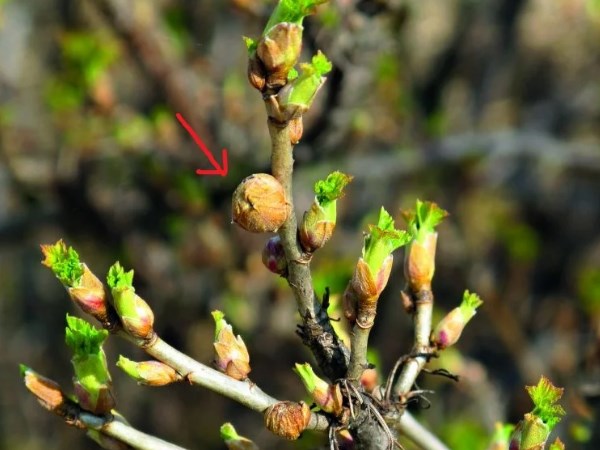
Content
Currant kidney mite: who is and why is it dangerous
The kidney mite is one of the main and most dangerous pests of black currant (red - less often affected, moreover, the signs are not so noticeable) and gooseberries.
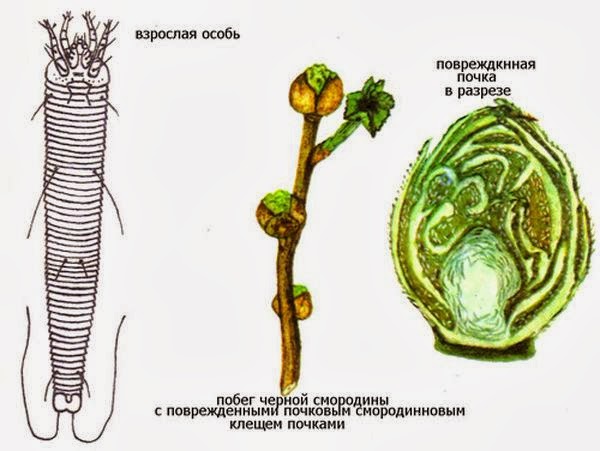
As we have already said, the main sign of damage to the berry by a currant kidney mite is the appearance of mite buds on the currant.
Remember! Tick buds always have swollen spherical shape (in some ways they even look like cabbage heads).
They can be found even in autumn or spring.
The fact is that inside such kidneys there are mites that feed on their juices, as a result, most of the kidneys dry up and do not open.
And those leaves and shoots that still appear from damaged buds develop slowly. The leaves themselves have a pale coloration and a deformed appearance.
Infection occurs in spring, during the period of bud swelling and the formation of a green cone, or rather, females hibernating in these buds begin to lay eggs.
A kidney mite begins its activity at temperatures above +5 degrees, while the optimal temperature for reproduction and settlement is +12 degrees.
Accordingly, if you do not get rid of the swollen buds (oviposition), then during the budding period and with the beginning of flowering, the mites will crawl out of them and begin to settle along the new young buds (re-infection will begin).
During the growing season, as a rule, several generations of the pest develop.
Thus, the main danger of a kidney mite affecting currants is that it damages the buds (future shoots and leaves). However, in addition to this, ticks also carry such incurable viral diseases as reversion of leaves and doubleness of flowers (more often they say "reversion or doubleness of currants").
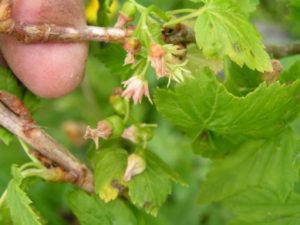
When to process currants for kidney mites
- Before bud break - treatment with boiling water, spraying with preparations based on vaseline oil, manual collection.
- Green cone - hand picked.
- Before flowering (budding) - spraying with acaricidal preparations (chemical or biological origin, weather permitting).
Biological products, as a rule, begin to work at temperatures above +15 degrees.
- After flowering, repeated spraying with acaricides (biological and chemical).
Measures to combat the kidney mite on currants: how to treat the bushes
Interesting! There are varieties of black currant that are resistant to kidney mites (Lama, Mila, Belorusskaya sweet, Vera, Sanuta, Orlovia, Wonderful moment, Rusalka, Sibylla, Dobrynya).
Pouring boiling water over bushes
Boiling water is one of the most popular folk remedies for early spring eradicating treatment of currants and gooseberries (in other words, this must be done before the kidneys swell, so to speak, as a preventive measure).
Advice! The site already has an article about how to handle currants and gooseberries with boiling water in spring.
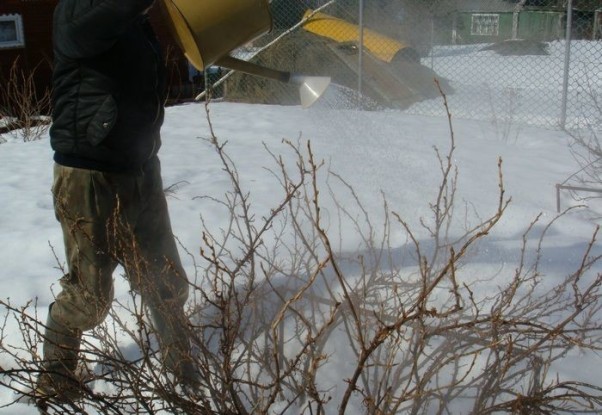
Manual collection
Perhaps the most effective and reliable way to fight kidney mites is by hand picking swollen buds (in other words, you need to pinch them off).
Advice! Tick buds must be collected in a separate container (jar), so that later burn!
In no case should they be thrown on the ground under bushes!
Distinguishing mite buds from healthy kidneys is quite simple (since they have a characteristic appearance): tick-borne — always round (swollen), whereas healthy - elongated.
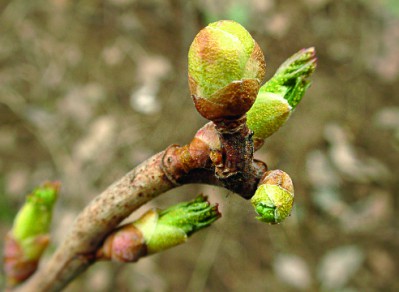
Moreover, it is desirable to collect mite buds as soon as possible, in other words, no need to wait for their disclosure.
By the way! In general, you can collect kidneys not only in spring, but also in autumn (signs of defeat are similar).
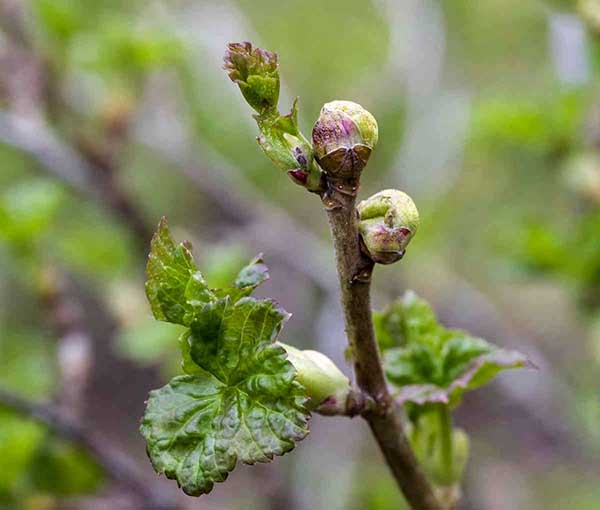
However! Manual collection makes sense only if the infestation is small and there are not very many mite buds on the bush.
If the defeat is strong, then without the use of chemical and biological acaricides, you cannot win.
Chemicals
Special means are used against ticks - acaricides. Conventional insecticides will not help you, you need insectoacaricides.
- Prophylactin (Vaseline oil and Malathion (Karbofos), enteric insecticide from wintering stages of pests);
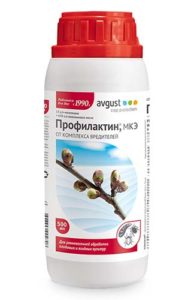
- Preparation 30 plus (Vaseline oil, contact insect-acaricide from wintering stages of pests);
Important! Spraying with these preparations (based on vaseline oil) is carried out in early spring, before bud break, at a temperature not lower than +4 degrees.
In short, when they spend eradicating early spring treatment.
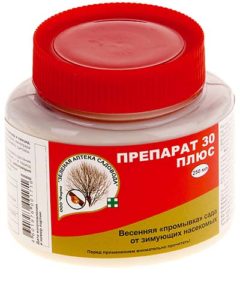
Note! If Preparation 30 plus consists only of vaseline oilthen in Prophylaxis also available Malathion (Karbofos), which significantly increases its effectiveness in the fight against ticks and other pests.
- Fufanon-Nova (Malathion (Karbofos), enteric insectoacaricide);
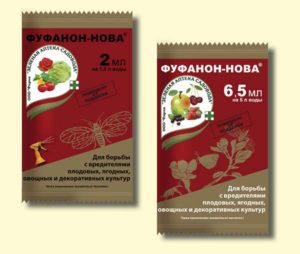
- Aliot (Malathion (Karbofos), enteric insectoacaricide).
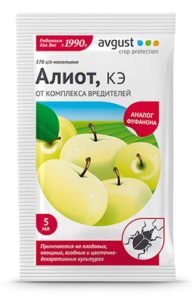
Fufanon-Nova and Aliot are complete analogs (they have the same active ingredient - Malathion (Karbofos).
- You can try using colloidal sulfur (a drug Tiovit Jet).
Note! It is useless to work with colloidal sulfur (Tiovit Jet) in cool weather (below +20). The optimum temperature is + 25-30 degrees, then the sulfur will evaporate and have a detrimental effect on the mites.
Therefore, sulfur is usually still not used to combat currant kidney mites.
Biologicals
- Fitoverm (Aversectin C, enteric contact insectoacaricide);
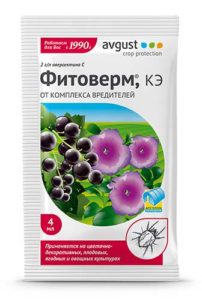
- Kleschevit (Aversectin C, enteric contact insectoacaricide);
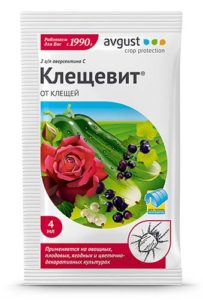
Fitoverm, Kleschevit and Aktofit - these are analogs drugs, they have the same active ingredient - Aversectin C.
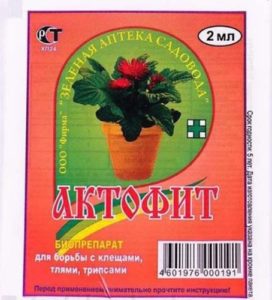
- Akarin (Avertin N, enteric-contact insectoacaricide).
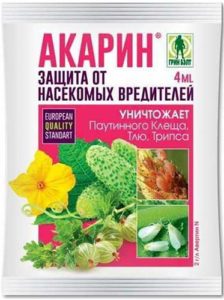
Other folk remedies
Many summer residents recommend pouring currant bushes before flowering mullein solution (for 1 bucket of water, 0.5 liter can of fresh mullein), which is also effective against aphids.
Kidney mite treatment recipe from Ivan Russkikh (host of the Procvetok channel): Dissolve 100 g of grated laundry or green soap in water, then pour in 100 ml of unrefined vegetable oil, mix thoroughly, dilute with 10 liters of water. Treat in early spring (before bud break).
By the way! In general, the use of unrefined oil and green soap is similar to the use of petroleum jelly-based preparations.
Video: saving the harvest of currants and gooseberries - treatment from a kidney mite
Some already desperate gardeners recommend getting rid of the bush altogether, or rather, cut a bush at ground level (and then burn all branches) so that new healthy and powerful shoots grow over the season. At the same time, it will take 3 years to wait for the new harvest.
However! Yet such a radical rejuvenating shrub pruning should only be done in the most extreme cases. Much better regularly cut currants in spring and / or autumn (after fruiting).
Well, now you know what to do if you find a kidney mite on a currant.
Let's be honest, fighting a tick is pretty difficult. Most likely, you will have to try all means (chemical and biological), including folk remedies (boiling water, etc.).

